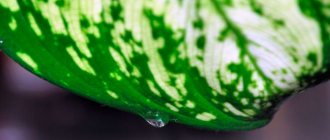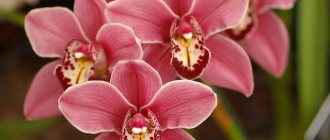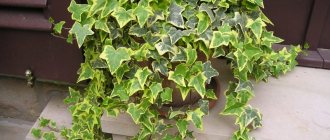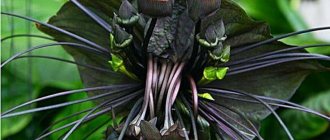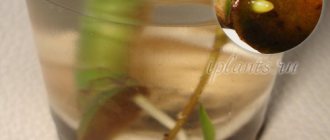- January 31, 2019
- Houseplants
- Marina Olenyuk
This spectacular flower is often used to decorate office spaces. It is found in government agencies, offices and even schools. There is an opinion that Dieffenbachia is a poisonous beauty. In this regard, a rather luxurious specimen may be sentenced to eternal expulsion from the apartment, even if until the moment of truth the owner loved and cherished the plant. Is it worth getting rid of it? Is the Dieffenbachia plant poisonous or are these just unfounded rumors? Right now you will learn some facts related to the benefits and harms of keeping a decorative leaf beauty in your home.
Popular speculation
Often, plants can be purchased based only on signs about them. A living tree is to improve the financial side of life, geranium is to ward off the evil eye, but the “heroine” of our article was immediately unlucky in this sense. Not yet knowing whether Dieffenbachia is poisonous or not, already unpleasant properties were attributed to it. The poor thing was called the flower of celibacy, endowing her with the ability to get rid of the owner in the room where she is. And if an unmarried lady decides to bring this flower into her apartment, seduced by its lovely wide leaves, then she will not find a soul mate forever and ever. Dieffenbachia is a poisonous “friend,” according to popular superstition; she will turn her owner into a divorcee or, worse, a widow in no time. Scary? But if you turn on prudence, you can remember more than one happy family that has the above-mentioned plant.
Superstitious people are very wary of the flowering of Dieffenbachia. As soon as she released the arrow, the owner of the house is deprived of his masculine strength, they think. Some go further and reinforce the horror story with the fact that if a couple has this flower and it suddenly puts out an ear, then the unfortunate people will not have children until they evict the innocent plant from the apartment.
Another legend is also associated with the flowering of Dieffenbachia. It is generally accepted that it occurs if there is a nervous atmosphere in the room. Frequent quarrels and scandals supposedly contribute to the appearance of a flower-cob. But these rumors have no scientific basis and are just popular speculation. A sane person understands that any plant blooms when external factors, similar to conditions in the wild, contribute to this.
Dieffenbachia signs and superstitions
Streptocarpus UA-Bolero, baby
The plant began to be cultivated under artificial conditions at the end of the 18th century and people immediately noticed that the juice of this flower was toxic. It is believed that because of this property, signs of Dieffenbachia appeared (the meaning of the flower has a more negative color). People who work with energy partly confirm superstitions, but they also highlight the positive properties of culture.
Dieffenbachia - why you can’t keep it at home, signs
Most of the negativity is associated with the popular names of this plant, for example, “widow’s flower” or “celibacy flower.” People consider Dieffenbachia to be a muzhegon, that is, if it is in the house, then the male energy will be weakened and repel representatives of the opposite sex. They explain whether it is possible to keep Dieffenbachia at home, popular signs among the people:
- Men will not only leave home, but they may have problems with potency, which will constantly get worse.
- It is not recommended to keep it in the bedroom, as conflicts will arise in the couple and there will be difficulties with procreation. There is a superstition among people that it will be difficult for a woman to become pregnant, and if this happens, then difficulties will arise in bearing the fetus.
- Another reason why Dieffenbachia is bad and why you can’t keep this flower at home is that it negatively affects a peaceful home atmosphere. Conflicts will constantly arise over the flower, and household members will be irritated and angry.
- According to superstitions, you cannot keep Dieffenbachia at home because it can cause health problems and the nervous system suffers to a greater extent, so a person can suffer from various neuroses, insomnia, and also feel tired and have headaches.
- Culture has a negative impact on the material condition of people, who will constantly feel a lack of funds.
- It is believed that Dieffenbachia also has a bad effect on pets that will try to leave the house, but small pets can become seriously ill and even die.
Dieffenbachia – why can’t it be kept in the office?
In fact, the ban on placing flowers in offices and other public places is a myth, and on the contrary, it is recommended to grow them there. If Dieffenbachia is in the office, signs indicate that it contributes to the development of business acumen, mental activity, intellectual abilities and efficiency. The energy of this plant helps you properly manage your finances and make the most of your business connections.
We found out why Dieffenbachia is bad and why you can’t keep this flower at home, but it is worth noting that it is useful when placed in places where there are a lot of people and especially if the building is located in polluted areas. Another plus in favor of this flower is that it prevents the spread of flu and colds through airborne droplets. The potty can be placed in the office, hallway and meeting room.
Dieffenbachia has bloomed - signs
Not everyone was able to see how Dieffenbachia blooms, since the process occurs extremely rarely. Bioenergetics specialists are confident that the plant is an indicator of the accumulation of negative energy. According to the sign, the flowering of Dieffenbachia warns that the energy atmosphere in the house is soon expected to deteriorate. She seems to be saying that something urgently needs to be changed to improve the situation. Gardeners try to cut the flower right away so that the plant does not lose all its leaves.
Description
The photos of the poisonous Dieffenbachia and its description given in the article will help you understand in general terms what kind of flower it is and why many, despite assumptions about its toxicity, still keep this beauty and love it very much.
The plant is native to the tropics of South America. More than forty species have been described by botanists to date. The assortment offered in flower shops makes it possible to acquire several different options. All Dieffenbachia are characterized by rapid development and growth. The beauty is in no hurry to bloom, and it is not very reasonable to expect gorgeous buds from it: all the beauty is in the leaves. The flower is a spadix with a light green covering leaf.
A brief excursion into history
There are about 50 species of Dieffenbachia, the country of origin of the flower is Brazil and a number of other countries in South America. This genus of the araceae family is famous for its evergreen deciduous plants, the main advantage of which is its large variegated leaves.
After the exploration of America, exotic plants often began to appear on neighboring continents and islands. This is how, with the ships of pirates and traders, Dieffenbachia was brought to the USA, Hawaii, Tahiti and other tropical regions. And only after that the flower was brought to European countries. In those days, Dieffenbachia was never responsible for severe poisoning or death of a person. At least not a single source mentions the dangers of this culture.
In America, the unpretentious plant quickly and well took root and even became the most common weed in some places. There, Dieffenbachia was not grown in pots, so the harmful qualities of the plant were never discovered. People noticed only one feature - the flower gradually replaced exotic crops, occupying the best lands and places under the bright sun.
For pets
Having learned whether Dieffenbachia is poisonous to people, let’s look at the situation with pets. Cats are very persistent in their desires, and if she decides to try this plant, rest assured, these cunning animals will get their way. When you're at home, you can ward off annoying foodies, but what happens when they're left alone? To avoid disaster, it is better to keep animals and Dieffenbachia in different rooms. Where the dangerous beauty will live, there is no place for curious four-legged creatures.
However, you should not fall into despair now, having discovered that that gorgeous flower that has been living with you for quite a decent time is nothing more than a poisonous Dieffenbachia. And at the same time, your beloved cat lives with you in the same rather modest living space. If he hasn’t touched the flower yet, then most likely he won’t do it.
Dogs can also taste Dieffenbachia, so it's worth taking safety precautions. The same goes for parrots. They can pinch off a piece of juicy greenery... For parrots, such a meal with a high degree of probability may be their last.
Pruning and rejuvenation
Young plants should not be pruned. But over time, Dieffenbachia becomes very elongated, its trunk becomes bare, and it loses its decorativeness and attractiveness. You can restore its aesthetic appearance in two ways:
- Trim the crown at a distance of about two cm from the node where the dormant buds are located, and try to root it. Blot the released juice with a napkin, then sprinkle with activated carbon. We described below how to root an apical rosette. The juice of this plant is poisonous, so carry out all manipulations carefully and wearing rubber gloves, and there should be no children or pets in the room. For pruning, use clean tools: a sharp knife or pruning shears. We recommend not watering the Dieffenbachia for four days before pruning in order to reduce the amount of toxic juice released from the wound.
- You can cut the bare trunk of Dieffenbachia at a height of about 10 cm above the soil. The cut should be horizontal, with smooth edges. The stump should have 2-3 buds for future shoots. Remove any drops of juice that appear on the cut with a napkin. Then sprinkle the cut with crushed charcoal or activated carbon. The stump should be covered with a glass jar or polyethylene to create a microclimate. The cover should be removed periodically for ventilation. When new sprouts appear, the shelter can be removed completely.
Do not be alarmed if, when pruning Dieffenbachia, its juice gets on your skin - wash it off immediately with cold water, and lubricate the area with some rich cream or oil.
Take action in time
What should you do if a drop of milky liquid gets on the skin of an adult who is not susceptible to allergies? Rinse the area with plenty of warm water as quickly as possible. You may be lucky and your body will not react violently to accidental contact. Under no circumstances should the juice come into contact with the mucous membranes. Eyes, nose, lips are very sensitive! After contact with eyes, the juice can cause blindness. In the other two cases, don’t expect anything favorable either.
If you feel dizzy or have headaches, call a doctor immediately. Difficulty breathing after contact with a plant or being close to it, confusion, difficulty speaking, and fainting are reasons to call the ambulance service.
With animals, if they have tasted the beauty, you need to do the same - urgently show it to a specialist. At the veterinary clinic, the doctor will provide the necessary assistance to your curious pet: he will rinse the stomach and prescribe further treatment.
Harm
- The main harm of Dieffenbachia is its poisonous juice, which, if it comes into contact with the skin and mucous membranes, can cause:
- chemical burn;
- swelling of tissues;
- poisoning.
In order to provide timely medical assistance to the victim, you need to know the main signs of Dieffenbachia poisoning:
- swelling of the tongue and lips;
- increased salivation;
- loss of sensation;
- suffocation;
- lack of swallowing reflex;
- diarrhea, vomiting;
- tearfulness of the eyes.
Important! Young Dieffenbachias do not have the same strong poison as adult plants.
Upon contact with their juice, a reaction does not appear on the skin, but it is still better not to taste them.
Benefits of Dieffenbachia
Despite all the dangers of the plant for people and animals, it is still loved and grown in apartments and other premises. This happens for some reason. First of all, the beauty of Dieffenbachia. Patterned bright leaves attract many gardeners. In addition to aesthetic pleasure, there is another good reason for growing the plant at home. The fact is that Dieffenbachia is an excellent indoor air purifier. Where there is at least one specimen of the plant, it is much easier to breathe. And here's why this happens:
- The presence of Dieffenbachia indoors reduces the level of formaldehyde in the environment. In addition to it, the plant absorbs a lot of dangerous fumes.
- There are significantly fewer pathogenic microbes in the air of the room where the beauty is located. Its phytoncidal properties are very valuable.
- The plant humidifies the air in the room well. Due to this, microscopic dust particles become heavier and a person inhales less of them.
Dieffenbachia in the house of omens
Over the years, people involved in breeding and maintaining flowers began to notice certain patterns
Over time, they have grown into signs that many people pay attention to. Here are just some of the likely consequences of purchasing a plant:
- It is believed that Dieffenbachia gets along only with women and does its best to drive men away from its owner. It weakens male energy, quarrels and destroys couples.
- Many people believe that a girl who keeps Dieffenbachia in her home will not get married until she gets rid of the flower.
- The presence of a plant in the bedroom of a married couple can cause the absence of children in the family. A green pet causes problems with potency and its noticeable decrease.
One of the signs is positive and even useful. It is noted that Dieffenbachia tries to bloom only in those houses where negative energy is present. At the same time, it not only acts as an indicator, but also absorbs all this negativity, carrying out energetic cleansing of the room.
An interesting feature of Dieffenbachia
The plant can “cry”. Transparent drops sometimes appear at the tips of Dieffenbachia, falling from the leaves especially intensely before rain. Other aroids have the same property, including philodendron and monstera. Sometimes a plant may “cry” after heavy watering. If you notice this, dry the soil and avoid frequent waterlogging. This can harm the plant: it will rot. Overmoistening is most dangerous during autumn and winter.
Diseases and pests
Dieffenbachia rarely gets sick, but if trouble strikes, in order to save the green beauty, it is important to know what dangers may threaten it.
- Fusarium. The main sign of the disease is that the leaves of the plant wither before our eyes and become covered with brown longitudinal spots. The reason is the presence of pathogens in the soil. For treatment, it is necessary to treat the plant according to the instructions with the fungicide “Fundazol” and transplant it into another pot with pre-treated soil. It is better to cut off diseased parts of the plant mercilessly.
- Anthracnose. With this disease, the tips of the leaves dry out, brown spots appear at the edges and spread throughout the plant. The cause of the disease is a violation of temperature and watering conditions. Perhaps the air in the room is too dry, the plant is rarely watered. Overmoistening of the soil and drafts in the room can also lead to this disease. Treatment-treatment of the affected plant with “Vitaros” or “Fundazol”, compliance with all necessary care rules: absence of drafts, air humidification, abundant watering no more than once a week.
- Leaf spotting is the appearance of brown spots with an orange edge on the leaf blades. The disease is caused by an abundance of humidity at a temperature too high for the flower. For treatment, you need to create comfortable conditions and treat the plant with a fungicide.
- Root rot is a sign that the plant is flooded. You need to remove it from the pot and remove the rotten roots. Places of cuts and possible wounds should be treated with activated carbon or trichopolum powder. If the roots are in very poor condition, it is better to cut off the remaining above-ground part of the plant and re-root.
- A viral disease - bronze, is characterized by the appearance on the leaves of a pattern in the form of circles and arched stripes with a shade of bronze.
- Viral mosaic looks like greasy spots randomly scattered across the leaf with white dots in the middle.
Important! To avoid infecting other plants, at the first signs of these diseases, all diseased seedlings must be treated with insecticides.
A diseased plant, sadly enough, will have to be destroyed. It is doomed to die and can infect all your flowers.
Mealybug
Pests cause considerable damage to the plant.
- Mealybug is an insect that attacks all parts of the plant: stems, stem, leaves. A characteristic sign of the pest is the appearance of deformation of the leaves, their rapid withering and the presence of white stains, as if they were sprinkled with flour.
- The spider mite destroys the flower, enveloping the trunks, leaves, and young shoots with a web. The tree begins to wither and shed its leaves.
- Thrips attacking a plant destroy it by sucking out the juice, which is safe for them. The leaves of the flower curl and dry, the plant freezes in growth and dies.
- Scale insects feed on the intercellular fluid of plants and leave behind small brown crusts that are difficult to remove from the surface of the plant. Like thrips, scale insects are carriers of dangerous viral diseases, the result of which is the death of the green darling.
To get rid of insects, you need to do several procedures.
- Carry out mechanical treatment of the plant. Carefully remove pests with your hands using a washcloth or cotton swab from each leaf, shoot, and trunk. Green special soap helps to cope with this task well.
- After removing the insects, treat Dieffenbachia with Actellik or Karbofos according to the instructions.
Let's sum it up
As it becomes clear from our article, Dieffenbachia is poisonous, but will only cause harm if it is treated negligently. If you do not chew the plant and work with it, protecting your hands with gloves, horrors will not happen. But the benefits of the flower are significantly reduced. Excellent cleaning properties should not be ignored. It is quite acceptable to keep it in office and industrial premises, in residential apartments and houses. It is enough just to stop communication between your child and the plant and to delimit the presence of animals together with him.
conclusions
From the features and properties of Dieffenbachia we have examined, we can come to certain conclusions about its safety (benefits and harms for humans).
If you take simple precautions during replanting, cutting stems and leaves (using protective gloves, washing your hands after finishing work with the plant), and not allowing children to come into contact with the plant, Dieffenbachia will be no different from other plants in the house. Thus, finding a Dieffenbachia flower in the house is not only not dangerous, but will also bring positive properties to the microclimate of the room
Also, this shrub with “marble leaves” will wonderfully complement and decorate your interior
Thus, finding a Dieffenbachia flower in the house is not only not dangerous, but will also bring positive properties to the microclimate of the room. Also, this shrub with “marble leaves” will wonderfully complement and decorate your interior.
Possible problems when propagating Dieffenbachia
To avoid negative consequences from improper plant propagation, you must strictly follow the algorithm for rooting an indoor flower. In addition, it will be necessary to create favorable conditions for the growth and development of Dieffenbachia.
There are a number of common mistakes that can be made when planting seedlings:
- Tools for working with the plant, soil, pot and roots must be disinfected to avoid the development of rot in the underground part of the plant.
- Selecting the wrong container. A container that is too tight may delay the development of Dieffenbachia. Pots with a large volume accumulate excess moisture, which creates optimal conditions for the development of rot and mold.
- Damage to the roots, stem or leaves of the seedling. Slow down the growth of the plant or cause its death.
Caring for the “witch”
Dieffenbachia is extremely easy to care for. She does not need any special soil; store-bought soil (for ornamental leafy plants) or garden soil from the garden will be sufficient. The only thing Dieffenbachia is demanding about is watering.
The plant is so tenacious that even in a drought of up to 2-3 weeks it will not die. But his beauty will suffer.
If watering is untimely, Dieffenbachia sheds its leaves, the stem becomes bare - it loses its attractiveness, which can only be returned by renewing the plant by rooting the top with leaves. Dieffenbachia is also undemanding in terms of pot volume. Replanting may be necessary only when a small pot cannot hold the huge bush of this beauty.
Even in a liter pot, this plant can reach a meter in length. To do this, of course, it needs timely watering and regular fertilizing with fertilizer once every 2 weeks. She loves this plant and organic matter - she will like an infusion of mullein made from bird or horse droppings. Dieffenbachia is beautiful and easy to care for. Is it possible to keep her at home? Of course yes.
The whole truth about the “vampire”
Dieffenbachia is a plant from the araceae family. Its most famous relatives are Aglaonemas and Anthuriums. The Dieffenbachia genus has several dozen species and hybrid varieties.
The most common are spotted (D. maculate) - a powerful plant with large dark green leaves, on which light spots and strokes are scattered in disorder, and painted (D. picta), the main light green background of the leaves of which gradually turns into a dark edging along edge.
Dieffenbachia is a very beautiful plant, its species are very diverse and sometimes it is impossible to take your eyes off such, for example, a “persona” of the plant world as Dieffenbachia Reflector (D. reflector).
The juicy dark green color of the leaves with small but abundant light green spots fascinates with its sparkling velvety - the leaves just sparkle in the sun. That's why it's probably a reflector.
It is residually poisonous, this plant, Dieffenbachia. Whether you can keep it at home is up to you to decide. Touching it is absolutely safe, but its juice is very poisonous.
If you have cats at home, you don’t have to worry about their health—the cat will never touch anything that could harm it.
But small children... These creatures do not know fear, and, moreover, they do not know about the poisonous juice of Dieffenbachia. They will need to be protected from this plant. But it can attract the attention of a little child - one Dieffenbachia bush can create a greenhouse atmosphere in a room. But superstitious ideas that the presence of a plant in an apartment leads to loneliness are absolutely groundless and harmful. There is an opinion that Dieffenbachia belongs to the category of “vampire” plants.
Is it possible to keep such a bush at home? This again, an opinion unsubstantiated by any scientific research, can only be justified by the fact that Dieffenbachia has fairly wide leaf blades that actively consume oxygen and emit carbon dioxide at night. Therefore, it is better not to place it in the bedroom.
Growing and reproduction conditions
Dieffenbachia is considered not just a capricious, but a problematic plant in terms of care. Constant care is needed so that the flower does not lose its decorative effect. This is a sensitive plant that will react to everything: excess or lack of light, moisture, temperature changes, etc. Beginner gardeners will find it difficult to grow Dieffenbachia.
To grow a beautiful and tall Dieffenbachia with lush foliage, you must follow some rules:
- Watering should be moderate. It is better to take filtered or melted water, settled. The tap water is too hard. You need to water as needed. It is enough to ensure that the soil in the pot is always slightly moist, but not dry or too sticky. In winter, you can water less often, allowing the top layer of soil to dry out.
- The flower must be constantly wiped with a damp cloth and the air around it must be sprayed. It is best to do this with gloves so that the juice does not get on the skin of your hands and cause an allergic reaction.
- Dieffenbachia needs to be fertilized especially carefully during the period of active growth, that is, in summer and spring. The flower does not accept all feedings. Fertilizers made from highly diluted lime are recommended for Dieffenbachia. Such fertilizing is applied every 10 days. Varieties with variegated leaves also like mineral fertilizers, but they are applied no more than a couple of times a month.
- If the plant begins to stretch out and lose foliage, you need to prune it. The top leaves are cut off and the juice is wiped away. This procedure will provoke the growth of new shoots on the stem.
The plant can be propagated by both seeds and cuttings. The procedure is very simple. The top of the plant is cut off, the sap that appears is wiped off, and placed in water until roots appear. Then it can be planted in a container with sand and peat. The cuttings should be kept at a temperature of about 22 degrees and protected from direct sunlight.
Since the plant grows quickly, it is recommended to propagate it every 3 years. The old flower loses its decorative qualities, so this procedure will help to grow a new Dieffenbachia.
